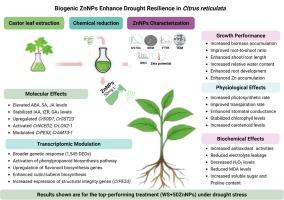Biogenic zinc nanoparticles modulate physiological, biochemical, and molecular mechanisms to enhance drought resilience in Citrus reticulata
IF 6.8
Q1 PLANT SCIENCES
引用次数: 0
Abstract
Water stress significantly impairs citrus productivity and threatens global food security. We evaluated the comparative efficacy of ionic zinc (iZn) and biogenic zinc nanoparticles (ZnNPs), synthesized from castor (Ricinus communis) leaf extract, in enhancing drought tolerance of Citrus reticulata seedlings. ZnNPs showed superior bioavailability due to their nanoscale size, uniform morphology, and crystalline structure. Under drought conditions, foliar application of 50 mg L⁻¹ ZnNPs enhanced relative water content (RWC), chlorophyll and carotenoid levels, and photosynthetic rate, resulting in greater biomass accumulation. Antioxidant enzyme activity (SOD, CAT, POD, and GST) was significantly enhanced. In contrast, the levels of oxidative stress indicators, including electrolyte leakage, H2O2, and MDA, were significantly reduced, indicating effective ROS scavenging and improved membrane stability. ZnNPs also modulated hormonal balance by elevating stress-responsive hormones (ABA, SA, and JA) while maintaining growth-related hormones (IAA and tZR). Transcriptomic analysis revealed 1545 differentially expressed genes (DEGs) in ZnNPs-treated plants compared with 639 in iZn-treated seedlings. Notably, upregulated genes included CrHSP70, CrWRKY40, CrSOD1, CrNCED2, CrLOX2–1, CrPE53, and CrAMT3–1. Additionally, ZnNPs uniquely activated key metabolic pathways, such as phenylpropanoid and flavonoid biosynthesis for oxidative stress mitigation and cutin/suberin biosynthesis to reinforce physical barriers against water loss. These findings provide the first integrated evidence that ZnNPs enhance citrus drought tolerance through coordinated molecular and physiological mechanisms, offering a sustainable nanotechnology-based strategy for climate-resilient horticulture.

生物源锌纳米颗粒调节柑橘抗旱性的生理、生化和分子机制
水分胁迫严重损害柑橘的生产力,威胁全球粮食安全。以蓖麻(Ricinus communis)叶提取物为原料合成离子锌(iZn)和生物源锌纳米粒子(ZnNPs),对比研究了离子锌(iZn)和生物源锌纳米粒子(ZnNPs)提高柑橘幼苗抗旱性的效果。ZnNPs由于其纳米级尺寸、均匀的形态和晶体结构而表现出优异的生物利用度。在干旱条件下,叶面施用50mg L - 1 ZnNPs可以提高相对含水量(RWC)、叶绿素和类胡萝卜素水平以及光合速率,从而增加生物量积累。抗氧化酶(SOD、CAT、POD和GST)活性显著增强。相反,氧化应激指标,包括电解质泄漏、H2O2和MDA水平显著降低,表明有效清除ROS和提高膜稳定性。ZnNPs还通过提高应激反应激素(ABA、SA和JA),同时维持生长相关激素(IAA和tZR)来调节激素平衡。转录组学分析显示,znnps处理的植株有1545个差异表达基因(DEGs),而izn处理的植株有639个差异表达基因(DEGs)。值得注意的是,上调的基因包括CrHSP70、CrWRKY40、CrSOD1、CrNCED2、CrLOX2-1、CrPE53和CrAMT3-1。此外,ZnNPs独特地激活了关键的代谢途径,如苯丙素和类黄酮的生物合成,以缓解氧化应激,角质素/亚木素的生物合成,以加强防止水分流失的物理屏障。这些发现首次提供了ZnNPs通过协调的分子和生理机制提高柑橘抗旱性的综合证据,为气候适应型园艺提供了可持续的基于纳米技术的策略。
本文章由计算机程序翻译,如有差异,请以英文原文为准。
求助全文
约1分钟内获得全文
求助全文
来源期刊

Plant Stress
PLANT SCIENCES-
CiteScore
5.20
自引率
8.00%
发文量
76
审稿时长
63 days
期刊介绍:
The journal Plant Stress deals with plant (or other photoautotrophs, such as algae, cyanobacteria and lichens) responses to abiotic and biotic stress factors that can result in limited growth and productivity. Such responses can be analyzed and described at a physiological, biochemical and molecular level. Experimental approaches/technologies aiming to improve growth and productivity with a potential for downstream validation under stress conditions will also be considered. Both fundamental and applied research manuscripts are welcome, provided that clear mechanistic hypotheses are made and descriptive approaches are avoided. In addition, high-quality review articles will also be considered, provided they follow a critical approach and stimulate thought for future research avenues.
Plant Stress welcomes high-quality manuscripts related (but not limited) to interactions between plants and:
Lack of water (drought) and excess (flooding),
Salinity stress,
Elevated temperature and/or low temperature (chilling and freezing),
Hypoxia and/or anoxia,
Mineral nutrient excess and/or deficiency,
Heavy metals and/or metalloids,
Plant priming (chemical, biological, physiological, nanomaterial, biostimulant) approaches for improved stress protection,
Viral, phytoplasma, bacterial and fungal plant-pathogen interactions.
The journal welcomes basic and applied research articles, as well as review articles and short communications. All submitted manuscripts will be subject to a thorough peer-reviewing process.
 求助内容:
求助内容: 应助结果提醒方式:
应助结果提醒方式:


